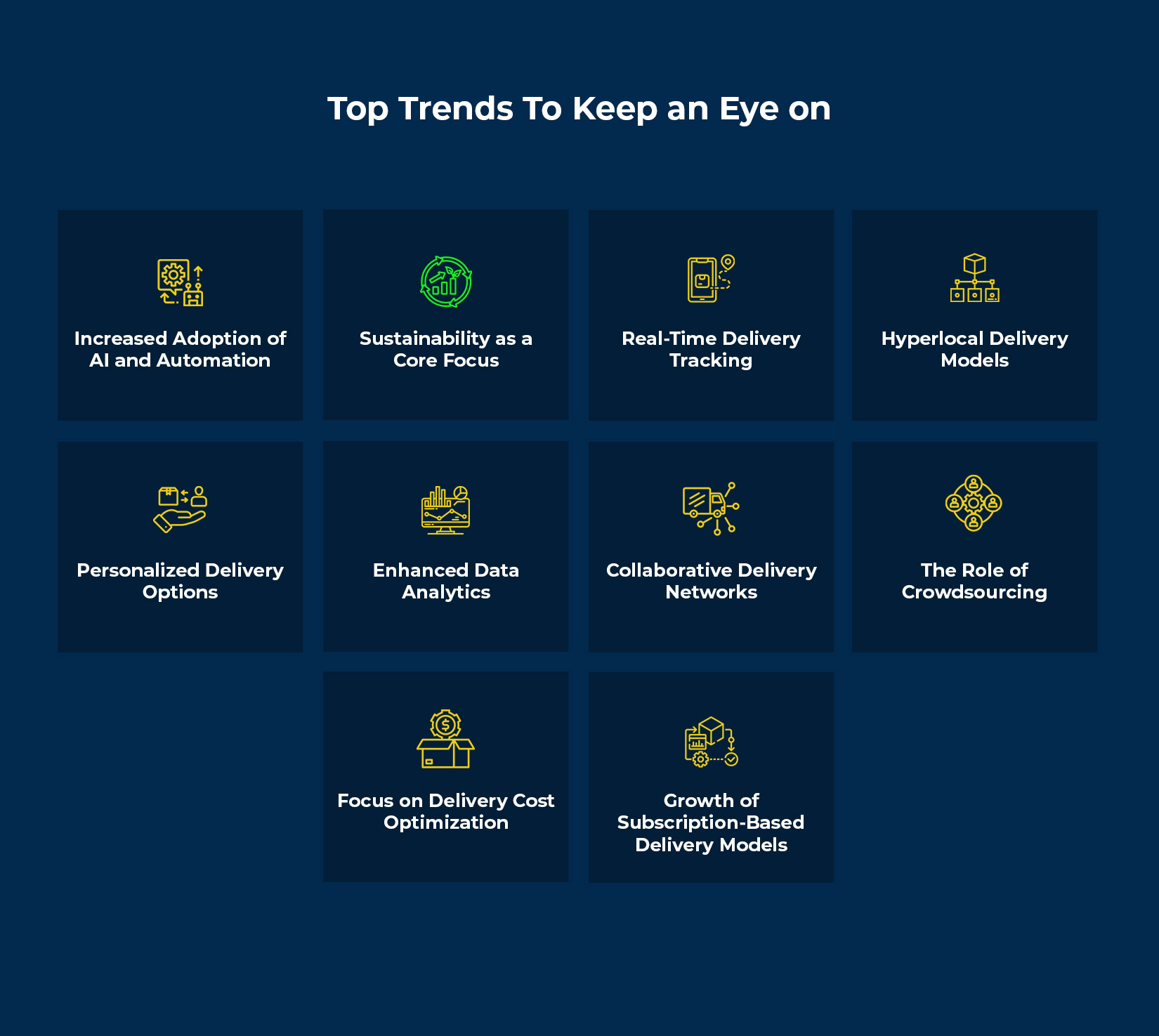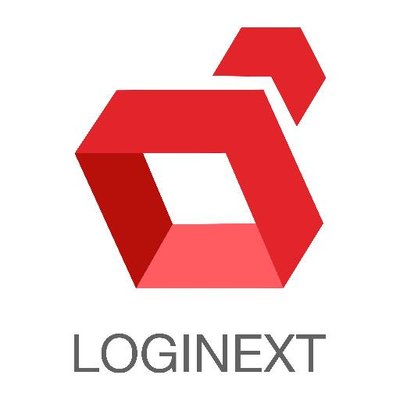
The last mile delivery industry is undergoing rapid transformation, driven by technological advancements and evolving customer expectations.As e-commerce continues to surge, delivering packages faster, cheaper, and more efficiently is essential. Businesses must prioritize these factors to remain competitive. By 2025, the global last mile delivery market is expected to exceed $200 billion. Companies are racing to improve their logistics strategies to meet the growing demand.
In this highly competitive landscape, businesses must embrace the latest innovations to enhance their last mile delivery system. From adopting AI-driven automation to implementing sustainable delivery practices, staying ahead requires constant adaptation. In this blog, we explore the key trends shaping last mile delivery in 2025. We also discuss how businesses can leverage the best last mile delivery software to improve efficiency, reduce costs, and enhance customer experiences.
Top Trends To Keep an Eye on

1. Increased Adoption of AI and Automation:
Artificial intelligence (AI) and automation are at the forefront of the last mile delivery revolution. AI is transforming logistics by optimizing delivery routes, managing real-time inventory, and enhancing warehouse operations. Automation, including autonomous delivery bots and drones, is helping companies meet rising demand while cutting costs.
A study by McKinsey predicts that over 80% of last mile deliveries will be automated by 2030, and by 2025, autonomous delivery vehicles will become more common in urban areas. These technologies reduce human intervention, minimize errors, and ensure faster deliveries.
Businesses adopting the best last mile delivery software equipped with AI can achieve smarter route optimization and predict delays. This helps reduce fuel consumption by up to 20%, resulting in significant cost savings.
2. Sustainability as a Core Focus:
Sustainability is no longer a choice—it’s a necessity. As governments and consumers prioritize eco-friendly practices, companies must integrate green initiatives into their last mile delivery systems. In 2025, businesses are expected to switch to electric vehicles (EVs) and use alternative delivery modes like cargo bikes and drones.
According to a report by Accenture, companies that adopt green delivery options could reduce their carbon footprint by up to 30%. In urban areas, businesses are experimenting with micro-mobility solutions to lower emissions and minimize traffic congestion.
Implementing an eco-friendly last mile delivery solution not only benefits the environment but also enhances brand reputation. Many consumers prefer to buy from companies with sustainable practices, making it a competitive advantage.
3. Real-Time Delivery Tracking:
Real-time delivery tracking has become a standard feature for customer satisfaction. A survey by Statista found that 94% of consumers want real-time tracking for their orders, and companies that offer this feature see a 50% higher customer retention rate.
Advanced last mile delivery tracking software provides live updates to customers. This reduces uncertainty and improves transparency for businesses. This trend also benefits businesses by identifying bottlenecks and optimizing fleet performance.
Real-time tracking systems use GPS and IoT to monitor packages from warehouses to doorsteps. These systems ensure accountability at every stage of the delivery process. Companies that fail to offer this feature risk losing customers to competitors who prioritize visibility.
4. Hyperlocal Delivery Models:
Hyperlocal delivery models are becoming the norm as customers demand faster and more convenient service. By establishing micro-fulfillment centers in urban areas, businesses can shorten delivery times and offer same-day or even one-hour deliveries
In 2025, hyperlocal models will be critical for industries like grocery, pharmaceuticals, and food delivery. Research shows that the hyperlocal delivery market is expected to grow at a CAGR of 23% from 2023 to 2030, driven by the need for speed and convenience.
To support this model, companies must implement a last mile delivery system. It should ensure seamless coordination between fulfillment centers and delivery agents. Businesses that fail to invest in hyperlocal infrastructure risk falling behind in a fast-paced market.
5. Personalized Delivery Options:
Customers want more control over their deliveries, and businesses must adapt by offering personalized options. In 2025, companies that provide flexible delivery windows, preferred drop-off locations, and rescheduling options will see higher customer satisfaction rates.
According to a survey by Capgemini, 74% of consumers are willing to pay more for personalized delivery services. This trend is particularly important in industries like retail and e-commerce, where customer experience can make or break a brand.
To offer personalized experiences, businesses must leverage advanced last mile delivery solutions that enable customers to customize their delivery preferences. This not only improves customer satisfaction but also reduces the risk of missed deliveries.
6. Enhanced Data Analytics:
Data-driven decision-making will play a critical role in last mile delivery in 2025. Companies that leverage big data and analytics can optimize their logistics operations, improve forecasting accuracy, and reduce costs.
According to Gartner, businesses that use predictive analytics in logistics can reduce operational costs by up to 15%. Advanced last mile delivery systems with built-in analytics can track key performance metrics. These include on-time delivery rates, fuel consumption, and driver performance.
By analyzing historical data and real-time insights, businesses can make informed decisions to improve efficiency and enhance customer satisfaction.
7. Collaborative Delivery Networks:
To tackle the rising costs of last mile delivery, businesses are increasingly turning to collaborative delivery networks. These networks involve multiple companies sharing resources, vehicles, and infrastructure to reduce costs and improve efficiency.
Advanced last mile delivery systems with built-in analytics track key performance metrics. These metrics include on-time delivery rates, fuel consumption, and driver performance.
Collaborative models allow companies to expand their delivery reach without significant capital investment. Using last mile delivery tracking software, businesses can coordinate deliveries across shared networks, ensuring efficiency and accountability.
8. The Role of Crowdsourcing:
Crowdsourced delivery models are on the rise, especially for same-day and on-demand deliveries. Companies like Uber, DoorDash, and Postmates have demonstrated the potential of crowdsourcing in improving delivery speed and reducing costs.
By 2025, crowdsourced delivery will become more mainstream. According to a report by Allied Market Research, the crowdsourced delivery market is expected to reach $170 billion by 2030.
Crowdsourcing allows businesses to scale their delivery operations quickly by using gig workers. To ensure smooth coordination, companies can implement last mile delivery tracking software that connects drivers, customers, and businesses in real-time.
9. Focus on Delivery Cost Optimization:
Last mile delivery accounts for 53% of total shipping costs, making cost optimization a top priority for businesses. Rising fuel prices, driver shortages, and customer demands for free shipping are putting pressure on logistics budgets.
Companies are adopting strategies like dynamic pricing models, automated route planning, and fleet management systems to reduce costs. A report by Deloitte suggests that businesses can reduce last mile delivery costs by up to 35%. This can be achieved by using the best last mile delivery software to optimize routes and manage deliveries efficiently.
10. Growth of Subscription-Based Delivery Models:
Subscription-based delivery models are becoming increasingly popular. Companies like Amazon Prime and Walmart+ have set a precedent by offering benefits like free shipping and priority deliveries through subscription services.
According to research by McKinsey, subscription-based services will grow by 20% annually through 2025, as consumers prefer predictable costs and faster service.
To support these models, businesses need a robust last mile delivery system that can handle recurring deliveries and manage customer preferences efficiently.
Also Read: Last Mile Delivery Software: A Comprehensive Guide
Conclusion
The future of last mile delivery in 2025 will be shaped by technological innovations, sustainability initiatives, and customer-centric approaches. Companies that adopt the best last mile delivery software and implement its advanced solutions will stay ahead of the competition.
By embracing the trends mentioned, businesses can enhance efficiency, reduce costs, and provide exceptional customer experiences. Staying ahead in this fast-evolving landscape requires continuous innovation and investment in cutting-edge last mile delivery systems.
The companies that succeed will be those that adapt quickly to changing customer demands and industry dynamics. They will ensure their last mile operations remain efficient, sustainable, and scalable. To thrive in the ever-changing world of last mile delivery, click the red button below to schedule a demo with LogiNext Solutions today.


